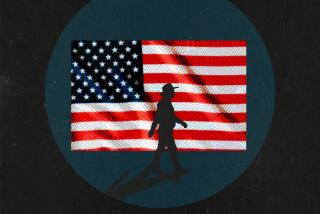Tilting at Movies
LONDON — There was a certain inevitable logic that Terry Gilliam would attempt to make a film based on Cervantes’ 17th century novel “Don Quixote.” He is, after all, one of the most quixotic of directors. Visionary, impulsive and unpredictable, Gilliam, 61, is a man who chooses to dream the impossible dream.
He had nursed the idea of a Don Quixote film for more than a decade but only started shooting it in Spain 16 months ago, when he believed the script (which he co-wrote with Tony Grisoni) was right and the budget high enough to accommodate his extravagant visual ambitions. At $32 million, “The Man Who Killed Don Quixote” was to be one of the most expensive films ever made solely with European money. Johnny Depp was to star, along with his girlfriend, the French singer and actress Vanessa Paradis. The 70-year-old French actor Jean Rochefort was cast as Quixote.
But six days after shooting began, Gilliam’s impossible dream was in ashes; the production had been visited by a series of disasters almost biblical in scope.
Rochefort arrived on the set feeling ill. He was suffering from a prostate infection and was in pain. On the second day of shooting, Depp and Gilliam were preparing scenes when a flash flood hit the set, covering props and costumes in mud and even washing some equipment away. The crew took a day to regroup, but when the rural landscape in northern Spain dried out, it had turned a different color; the scenes already shot would not match. Rochefort’s health declined; on the fifth day, he was flown home to Paris and underwent a double hernia operation. On the sixth day, some of the film’s insurers withdrew their backing.
When films crash and burn in such a fashion, it usually happens away from the public gaze. But Gilliam had invited Keith Fulton and Louis Pepe, Los Angeles-based documentary makers, to film the production and its preliminaries. Their cameras started rolling eight weeks before Gilliam started principal photography; their aim was to show how a film like “The Man Who Killed Don Quixote” gets off the ground. As it was, they were able to chronicle the disintegration of an expensive movie. The result, a 90-minute documentary called “Lost in La Mancha,” receives its world premiere at Berlinale, Germany’s international film festival, on Monday.
“We knew Terry had wanted to make a Quixote film for so long,” said Fulton, partner with Pepe in the Silver Lake company Low Key Pictures. “And we felt there was a strong parallel between that and the story of Don Quixote himself. Terry has been tilting at windmills for years. Louis and I had been on his sets before, so we knew it would be a fun ride.”
Gilliam became famous as the inspired animator in the Monty Python troupe, before moving into directing films. When formulating a visual notion of a film in his head and then trying to capture it on screen, he often resists budget or time limits.
Over the years, he’s clashed with studios, producers and financiers. In 1985, he fought publicly with Universal chief Sid Sheinberg, who wanted to cut his film “Brazil” by 11 minutes. At one point, the studio declined to release the movie in its longer form, so Gilliam organized a special screening for the Los Angeles Film Critics Assn., which responded by voting it the best film of that year.
On his flamboyantly visual “The Adventures of Baron Munchausen” (1989), the budget spiraled out of control. And as Fulton and Pepe showed in their documentary “The Hamster Factor,” about the making of Gilliam’s film “Twelve Monkeys” (1995), that set too was often fraught with dissent and disputes. Still, the debacle of “The Man Who Killed Don Quixote” was an experience that had nothing to do with artistic squabbles or clashing temperaments. The events were largely beyond Gilliam’s control.
Shooting “Lost in La Mancha” was a new experience for Fulton and Pepe. They have shot on film sets before; Low Key Pictures also makes promotional material about movies, as well as EPKs (electronic press kits.) “But nothing much happens on most movies,” said Fulton. “It’s pretty straightforward stuff.” On “The Man Who Killed Don Quixote,” however, they found themselves documenting an unfolding dramatic story.
“Of course,” said Pepe, “we had no idea going into this that Terry’s film would fall apart.”
But fall apart it did, and consequently “Lost in La Mancha” is compelling. Gilliam, his producers, backers, cast and crew start out in a spirit of nervous optimism, but are finally dispirited. Some scenes are vivid: the unfortunate Rochefort, visibly wincing in pain as he tentatively mounts his horse; the doomed attempts to keep shooting, foiled by thunder, the noise of F-16s flying from a nearby military base; and the deluge that flooded the set. It’s comparable to witnessing a traffic accident; one feels for those involved, but it’s almost impossible to look away.
Though Gilliam allowed Fulton and Pepe access to the cast, crew and stormy production meetings, their film does not flatter him; it records his colleagues’ ambivalent opinions. “With Terry, nothing is ever simple and plain,” sighs Nicola Percorini, the film’s Italian cinematographer. “Making a film with Terry is like riding a pony bareback,” says the first assistant director. And when the producers call a meeting without Gilliam to announce the film has been abandoned, an angry crewman snarls at the camera: “Where’s the director?”
“It will interest anyone who wants to know about the creative process of filmmaking and the fragility of it,” said “Lost in La Mancha’s” British producer, Lucy Darwin. “We knew that potentially we had a great project on our hands, whatever the outcome of Terry’s movie. ‘Lost in La Mancha’ lasts 90 minutes, but because of the way things worked out, we shot 100 hours of film.” Encouraged by its acceptance into the Berlin festival, Darwin is hoping for a limited theatrical release in the U.S., Britain and some European territories.
Compared to “The Man Who Killed Don Quixote,” “Lost in La Mancha” (narrated by Jeff Bridges, star of Gilliam’s “The Fisher King” [1991]), is modestly budgeted; it cost less than $500,000 and was independently financed, with Darwin, Fulton and Pepe investing along with relatives and others. Still, Gilliam likes it enough to go to Berlin and help publicize it.
“I’ll be reliving the pain and the torture,” said Gilliam, who lives in London. “But I think the film is interesting and revelatory. It was a diary, with no intention that it should become a Greek tragedy. But you’re watching people die, basically. It’s the curse of Quixote.”
He says this because the Cervantes novel has proved hard to film in the past. Orson Welles made an ill-fated attempt in 1957 but never managed to complete his film.
Why did Gilliam agree to let Fulton and Pepe record his film falling apart? “If you do these things, you have to be honest and open,” he said. “And also there’s a degree of narcissism involved.” Meaning he’s something of a ham when a camera is pointed in his direction? Gilliam emitted his trademark high-pitched giggle. “That’s an understatement.”
An achievement of “Lost in La Mancha” is that it leaves viewers curious about how “The Man Who Killed Don Quixote” would have turned out. The good news is that Gilliam still plans to make it: “I’ve just been talking to the lawyers for the insurance company. I’m trying to buy back the rights to it. It would mean a different cast, and new people involved, but yes, I’d like to do it.” He never gives up, does he? Gilliam sighed. “No. I never learn. I never get any wiser.”
More to Read
Only good movies
Get the Indie Focus newsletter, Mark Olsen's weekly guide to the world of cinema.
You may occasionally receive promotional content from the Los Angeles Times.









